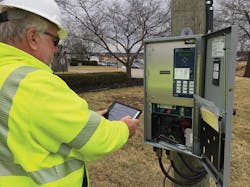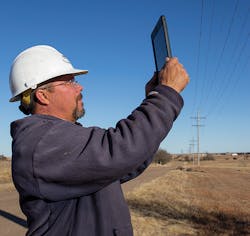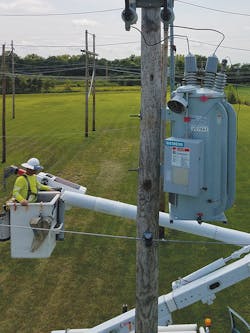In 1996, journeyman Wayne Kenniker was climbing poles, competing for the first time in the International Lineman’s Rodeo in Bonner Springs, Kansas, U.S. Back home in Iowa, his typical day as a lineman included building line extensions, responding to trouble calls, and carrying a pen, paper and a clipboard to make sketches and complete the job ticket. Fast-forward from grunt to lineman, foreman to supervisor and now as project manager for Utility Lines Construction Services (ULCS), an Asplundh company, Kenniker’s responsibilities include developing applications for ULCS crews’ mobile devices.
“They call me the ‘app builder,’” Kenniker said, referring to one of his ongoing projects of converting the utility’s traditional pen and paperwork forms to a mobile device platform. “Using GoCanvas, we are creating custom mobile applications and processes for everything from pole line and transmission tower inspections to ordering [personal protective] equipment on tablets or smartphones.”
A wide variety of apps like GoCanvas are popping up for an assortment of electric utility field applications, serving as a modern tool in the lineman’s toolbox and providing numerous benefits.
Apps for Linemen
Following are a few notable apps and how they can help linemen and utilities:
• Lineman Guide, by Lineman Trainer, provides convenient access to charts, pictures and how-to information for transformers, rigging, knots and rope capacities. The app also contains conductor formulas, general formulas, calculators for rigging-sling tension and rigging-gin loading, line-to-line voltage chart electrical distribution systems chart and more. A sister app, Lineman Training, includes question-and-answer exercises. Both Apple and Android users also can access voltage regulation standards, wire size and amp rating, ampacities of insulated conductors, ampacity correction for temperatures, conductor formulas, guy formulas and more.
• LineSmarts, by LineSmarts Ltd., provides field personnel with a range of overhead power line measurement and engineering analysis tools, including assessment of conductor tension, usage and sag, structure dimensions, span length, falling tree clearance, ground clearances and more. The Android app uses multiple sensors in smartphones and tablets together with range data to create calibrated images from which the measurements are made.
• Lineman Calculator Pro, by Power Lineman, enables field technicians to calculate distribution transformers’ kilovolt-ampere loads as well as determine kilovolt-ampere full-load currents, turns ratios, connections, loads, line currents, phase currents, line voltage and phase voltages. Both Apple and Android versions also can be used for training purposes by working the formula without a calculator and then checking the answer.
• Unit Converter Pro, by Elkens Software, converts more than 1500 different units in 80 categories, such as conversion factors for length, area, volume, mass, force, energy, temperature and time units. On Android or Apple devices, the app includes angle, area, currency, data storage, data transfer, length, density, energy, flow, force, fuel efficiency, mass, length, numbers, power, pressure, sound, temperature, time, velocity, volume converters and many others.
• Utility Stats, by EnerNex LLC, is a searchable database app available for Apple iOS devices. The app provides detailed information about more than 3300 U.S. totals of megawatt-hours of electricity delivered each year, number of customers served, annual revenues and more. It can be filtered by several criteria or searched by entering the name of the utility.
• Voltage Drop Calc, by Southwire LLC, helps line workers to determine the proper wire size for an electrical circuit based on the voltage drop and current-carrying capacity of an electrical circuit. Available for both Apple and Android devices, the app can calculate wire size to meet specific voltage drop limits as well as the voltage drop for a specific conductor run. When sizing conductors, the calculations limit wire size to voltage drop and National Electrical Code ampacity.
Developing Apps
For many utilities the migration to in-house app development begins with a specific need. “We got hooked on developing our own mobile apps after cutting our teeth on iFormBuilder,” said Denzil McGill, vice president of information technology at Victory Electric Cooperative Association Inc. “Our initial mission for the Zerion Software app was to automate our paper-based field data collection processes. But when winter storm Jupiter hit southwest Kansas in January 2017, we needed something quick.”
With Victory Electric contractors and cooperative mutual-aid crews en route, the customizable software enabled McGill’s emergency coordination team to design a storm restoration form quickly. With the app Disaster Recon 2017 on their mobile devices, assessment crews could collect storm-damage data — pictures, damaged assets, GPS location, a condition ranking and replacement parts needed — on their mobile devices, all in one form.
The reports were sent in real time to Victory Electric’s coordinators, who immediately could determine the scope of the damage and send restoration crews where they were needed most. At one point, with 1-inch (25-mm)-thick ice on poles and lines, nearly half of Victory Electric’s 19,000 meters were without power.
Another Approach
Victory also anticipated the paperwork that was just around the corner. “After the storm, we designed the app to generate crucial documentation and supporting information, which is required by the Kansas Emergency Management office and FEMA,” McGill said.
All nine counties served by Victory Electric received disaster declarations and are hoping to receive federal aid, when available. In June 2017, realizing the benefits of software development, Victory Electric hired a skilled software developer from West Virginia University, charged with assisting in the development of more mobile apps for tailgate meetings, meter installations, transformer installations, light installations, equipment and truck inspections, equipment inventory controls, vehicle maintenance requests, hazard reports and even Board of Trustee surveys.
Hardware Preference
The verdict is still out on mobile device preference. A large West Coast utility recently conducted a companywide mobile device evaluation survey among its field personnel. The study found some field personnel still prefer a laptop mounted in their truck, because they like the larger screen for circuit maps and detailed drawings. Others prefer iPads and tablets, because of the advancements in data entry with electronic pens and touch screens.
Field personnel also are beginning to use their smartphones, taking advantage of the high-quality photo capability, navigation tools and app-friendly environment. Smartphones are ideal for backyard trouble calls and managers needing 24/7 access to the utility’s central geographic information system (GIS) when they are away from their work vehicle. Experts predict smartphone use will continue to grow, in part because of the native apps, or stand-alone software programs, downloadable from the Google Play and iTunes app stores.
After all, as one superintendent commented, “Everyone has a smartphone in their back pocket.”
The Hidden Danger
Southwire began developing downloadable mobile apps four years ago to provide specifications and modeling tools to install their products. Mark A. Lancaster, director of intelligent grid and energy solutions at Southwire, reflected on the company’s experience with mobile apps, saying, “As with any software, apps are simply a tool that must be properly understood before being used by power professionals. Some apps, like product catalogs, are informational and are relatively simple and straightforward to use. However, apps that perform design calculations must be understood to prevent their misapplication.”
Southwire developed apps to provide comprehensive data and modeling tools to install its products safely and correctly. “When using apps, it is important to know how they work,” Lancaster cautioned. “Some information provided in apps, such as ampacity ratings, can vary significantly based on the installation conditions. “The conditions assumed in the apps are usually shown but may not match those for the work you are doing.”
Apps make getting answers to complicated design questions appear easy, but there is a hidden danger in this. “Our apps are tools to enable knowledgeable professionals to do their jobs,” Lancaster said. “The user, whether you are a lineman or engineer, still needs experience to know how to use the tool and when they are using it the wrong way.”
Troy Moss of GoCanvas reflected, “When we entered the mobile application space in 2008, our goal was empowering field workers and administrators to help them turn their mobile devices into productivity tools. Today, we have over 28,000 customizable templates posted on our website, created by increasingly tech-savvy back-office and field personnel.”
Fulcrum, Quick Base, TerraGo and many other customizable software companies are doing the same. Mobile apps exist for everything from outage management and pole line extensions to substation maintenance and staking.
Northpower, a New Zealand utility, reduced per-day inspection of its 85,000 pillars (poles) by approximately 40% using one of Fulcrum’s simple inspection apps. “Converting paper-based maps and manual data collecting to iPads has also helped Northpower trouble call crews to pinpoint a faulty pillar and provide better route planning,” said Barry Beckner of Fulcrum.
Field Design
Peter Batista, senior engineer at UC Synergetic, explained how no-code mobile apps can be updated in the field. “A technician in the field can quickly populate the Quick Base forms to gather and verify information — for example, to check the status of a recloser and its control cabinet — using drop-down answers and check boxes. Created with company-specific nomenclature, reporting errors are eliminated,” Batista explained. “If an additional field category is needed to capture missing information — for example, to note a joint-use tenant’s assets discovered on the pole — the technician can switch to the setup mode and add a new data entry field, without coding skills.”
The Next Wave
The next wave of mobile device apps will include connectivity to other devices by radio frequency, wireless carrier and Bluetooth. Several manufacturers are adding a Bluetooth chip to their test and measurement tools. Drone service company Measure just released Ground Control, a mobile app that enables linemen to view drone imagery on their iPad while automatically collecting and uploading feeds to a cloud-based drone management system. Smart grid devices and sensors bridged to cloud management technology enable technicians remote access to data and functionality through a mobile device from any location.
Other mobile device innovations in the pipeline include augmented reality applications, which will take mobile apps and GIS technology to a new level. Index AR Solutions is deploying AR apps to several utilities for training and common field practices. In its LineAssist SuperApp, Index has developed an AR app that troubleshoots five separate controllers as well as the installation and removal of four specific voltage regulators. AR on any mobile device enables field crews to see preinstalled 3-D virtual imagery of the controllers and regulator on the mobile device screen, superimposed over the actual real-time view on the screen.
Operational efficiency, reduced response times, increased productivity, better planning and scheduling, network intelligence, enhanced data quality and accuracy — these are the many benefits of today’s mobile apps, and there are even more to come. ♦
Check out the April 2018 issue for more articles, news and commentary.



